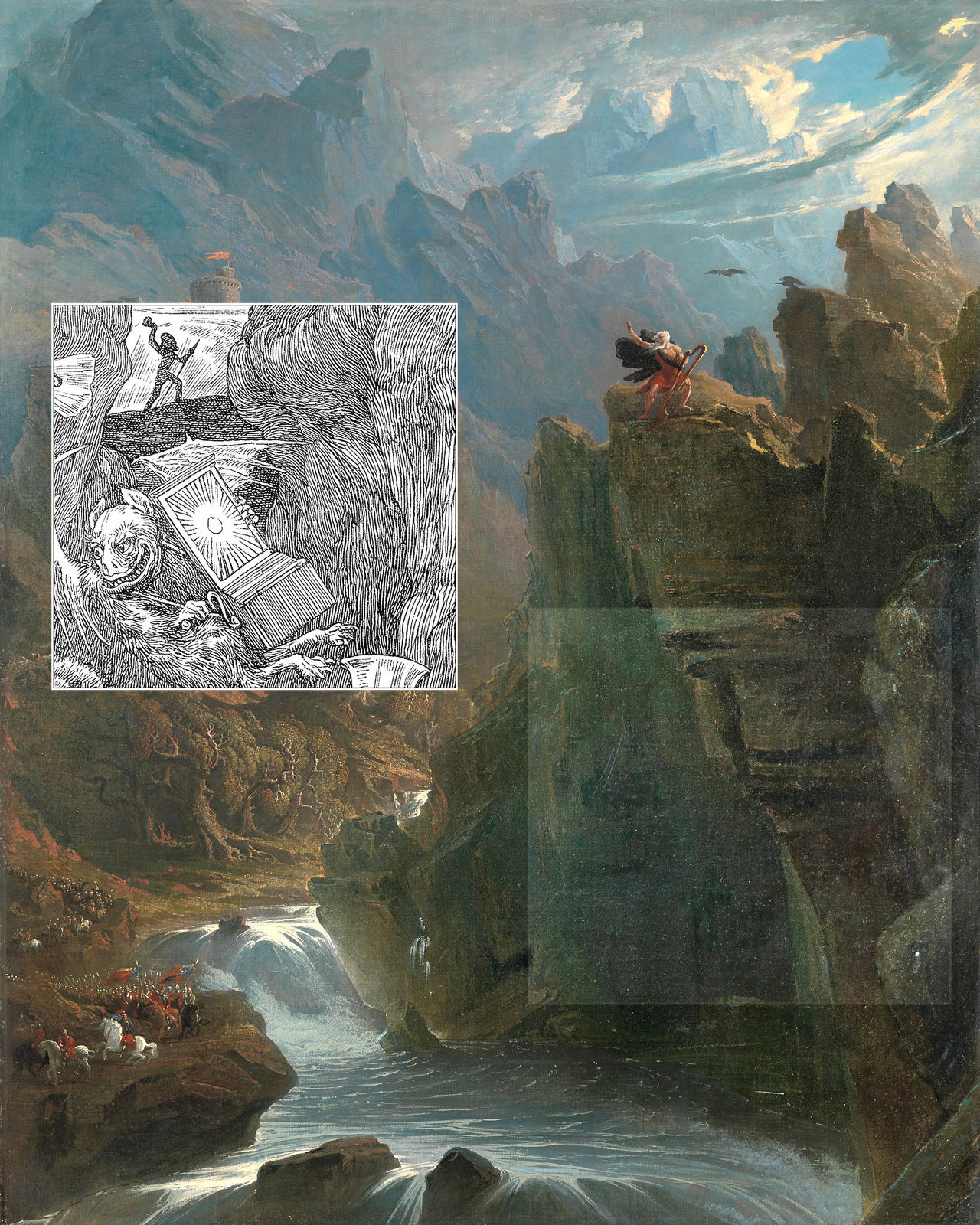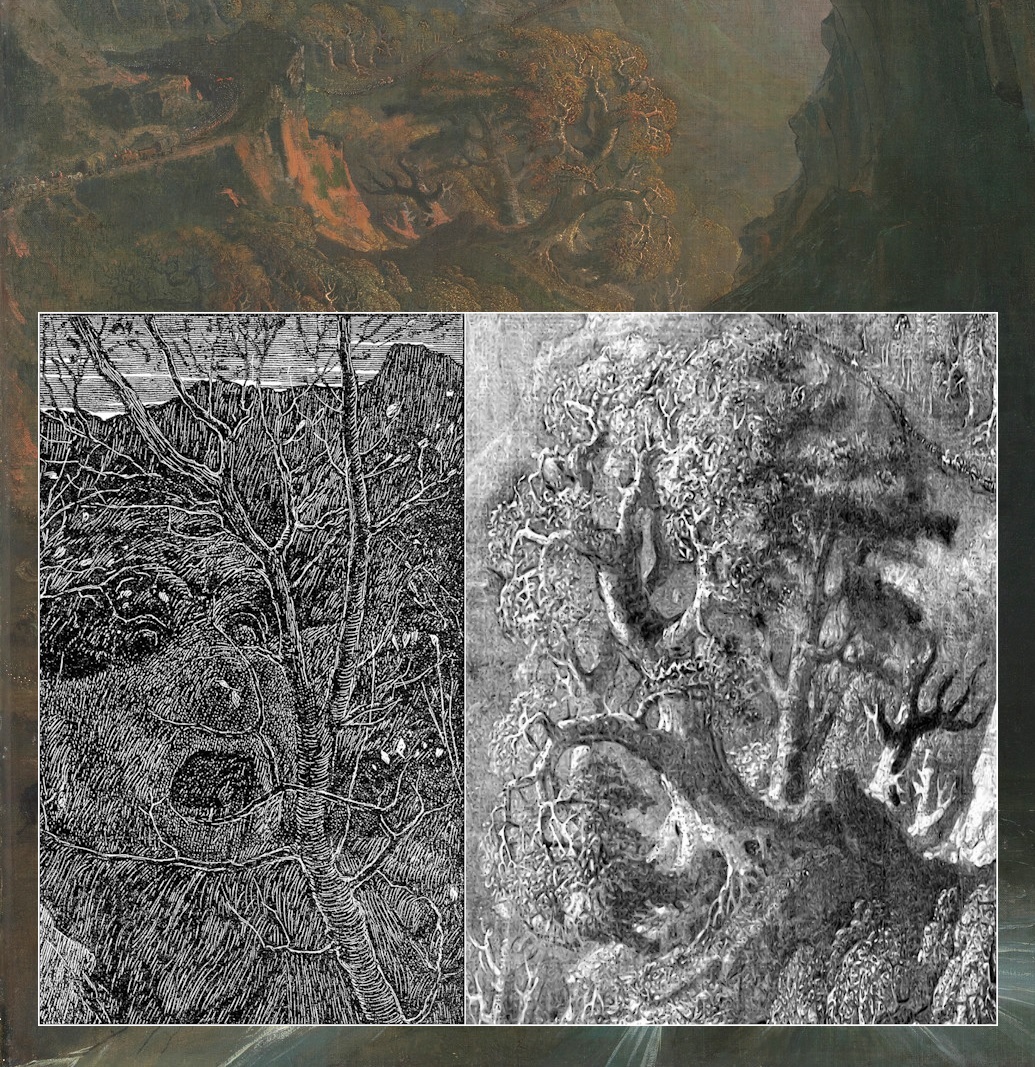
Illustration drawn by Philippe Jacques de Loutherbourg (engraved by Hall…) to Edward Jones’s Musical and Poetical Relicks of the Welsh Bards (1784)

- [main image]: John Martin, The Bard (ca. 1817); by GIMP: contrast enhanced in the rock area & light areas delated.
- [inset]: Henry Holiday (engraver: Joseph Swain), illustration (1876) to the chapter The Beaver’s Lesson in Lewis Carroll’s The Hunting of the Snark, detail
- [upper inset in the mostly grey shaded image]: Detail from preperatory draft by Henry Holiday
- [photo]: Mirrored view of a rock structure in the Valley of the Kings (see quote from John Tufail below)
As John Tufail showed, Holiday also could have referred to a rock structure in the Valley of the Kings.
One of the more interesting changes that Holiday made between his preliminary sketch and the final illustration lies in his drawing of the cliffs and rocks that surround the two protagonists. In the preliminary sketch, the cliffs present a ghoulish appearance looming threateningly over the Butcher and Beaver. The final illustration presents a quite different, though equally threatening aspect. Instead of simulacra reminiscent of ghoulish faces the now vertically fissured cliffs have a torso-like appearance.
In fact the whole of Holiday’s presentation of this landscape is remarkably like the dramatic terrain of the Valley of the Kings.
(Source: p. 29 in John Tufail, The Illuminated Snark, An enquiry into the relationship between text and illustration in ‘The Hunting of the Snark’ (PDF), 2004.)
There are various ways available to an artist to refer to another artist’s work. Henry Holiday mostly refers to shapes and patterns in the referenced image. In the following example M.C. Escher refers to the whole concept of John Martin’s painting. (This comparison is a bycatch from my Snark hunt, which I made in 2013):
- [left] Maurits Cornelis Escher: Cimino Barbarano, 1929 (in Escher’s “Italian” period). This reproduction (strongly shrinked in order to make it unusable for commercial purposes, but large enough for research) of the original print has been horizontally compressed and segments on the right side and of the left side of the image have been removed.
- [right] John Martin: The Bard, ca. 1817. The colors of the original painting have been completely desaturated and segments on the top and the bottom of the image have been removed.
M. C. Escher might have made his print based on a real landscape which he saw when living in Italy. Or he was inspired by John Martin’s painting. Or Escher and Martin both might have been inspired by an earlier drawing of that alpine scenery. As for John Martin, even though his impressive landscape is related to events in Wales under the rule of Edward I (more about the Dolwyddelan Castle in northwest Wales), Martin took inspiration from real alpine landscapes.
Back to Henry Holiday. I think that he in his illustrations to The Hunting of the Snark there are many references to Martin’s Bard. Below you see a quite good example for such a reference.
- [left] Henry Holiday: Illustration to chapter The Vanishing in Lewis Carroll’s The Hunting of the Snark, detail
- [right] John Martin: The Bard, mirror view of a horizontally compressed and vectorized detail.
(Twitter)
Monsters:
 If you know that pareidolia lets you see monsters in knobby branches, then you can play with that as an artist too.
If you know that pareidolia lets you see monsters in knobby branches, then you can play with that as an artist too.
- [main image] John Martin: The Bard
- [inlay] Detail from Henry Holiday’s illustration to the chapter The Beaver’s Lesson in The Hunting of the Snark
- [inlay in inlay] Detail from The Bard
(Twitter)
There is more:

Horses can turn into playfully frolicking weeds:

- [left] Henry Holiday: Illustration to chapter The Vanishing in Lewis Carroll’s The Hunting of the Snark, detail
- [right] John Martin: The Bard, reproduction of a detail.
Related blog posts:
- The Bard (for comments: Instagram)
- Monstrances (for comments: Instagram)
- Cheeky
2017-09-09, update: 2022-01-05



